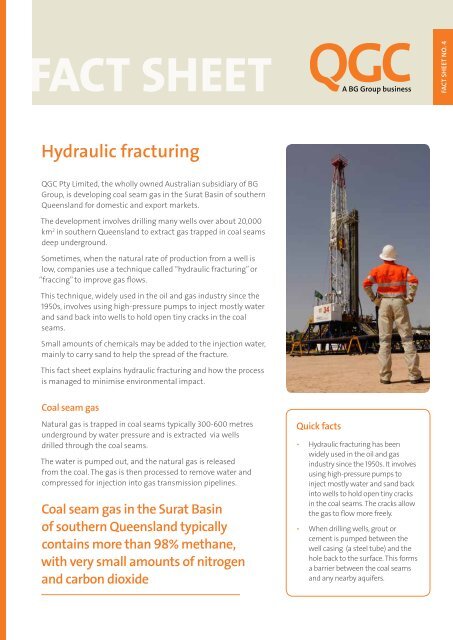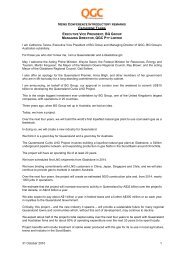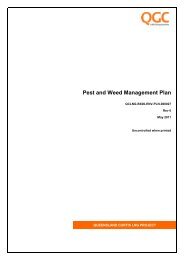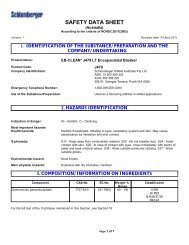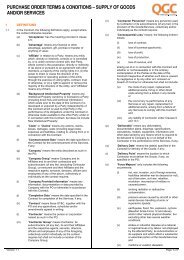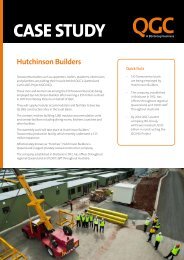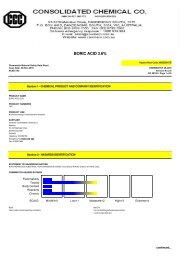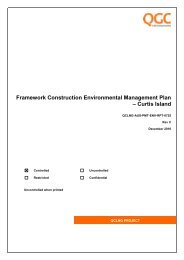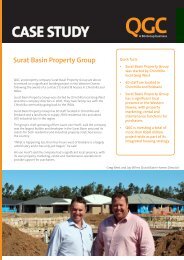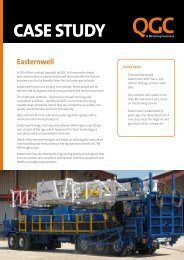Hydraulic fracturing - QGC
Hydraulic fracturing - QGC
Hydraulic fracturing - QGC
You also want an ePaper? Increase the reach of your titles
YUMPU automatically turns print PDFs into web optimized ePapers that Google loves.
FACT SHEET NO. 4<strong>Hydraulic</strong> <strong>fracturing</strong><strong>QGC</strong> Pty Limited, the wholly owned Australian subsidiary of BGGroup, is developing coal seam gas in the Surat Basin of southernQueensland for domestic and export markets.The development involves drilling many wells over about 20,000km 2 in southern Queensland to extract gas trapped in coal seamsdeep underground.Sometimes, when the natural rate of production from a well islow, companies use a technique called “hydraulic <strong>fracturing</strong>” or“fraccing” to improve gas flows.This technique, widely used in the oil and gas industry since the1950s, involves using high-pressure pumps to inject mostly waterand sand back into wells to hold open tiny cracks in the coalseams.Small amounts of chemicals may be added to the injection water,mainly to carry sand to help the spread of the fracture.This fact sheet explains hydraulic <strong>fracturing</strong> and how the processis managed to minimise environmental impact.Coal seam gasNatural gas is trapped in coal seams typically 300-600 metresunderground by water pressure and is extracted via wellsdrilled through the coal seams.The water is pumped out, and the natural gas is releasedfrom the coal. The gas is then processed to remove water andcompressed for injection into gas transmission pipelines.Coal seam gas in the Surat Basinof southern Queensland typicallycontains more than 98% methane,with very small amounts of nitrogenand carbon dioxideQuick facts• <strong>Hydraulic</strong> <strong>fracturing</strong> has beenwidely used in the oil and gasindustry since the 1950s. It involvesusing high-pressure pumps toinject mostly water and sand backinto wells to hold open tiny cracksin the coal seams. The cracks allowthe gas to flow more freely.• When drilling wells, grout orcement is pumped between thewell casing (a steel tube) and thehole back to the surface. This formsa barrier between the coal seamsand any nearby aquifers.
A mixture of water and sand ispumped back into the well.Increasing flow ratesExploration and appraisal wells are drilled todetermine whether a coal seam holds commercialquantities of natural gas.These wells help us to understand the permeabilityof the coal, or the rate at which fluid or gas can passthrough the coal, and gauge the production capabilityof a particular area underground.Wells with higher flow rates of gas are typically moreefficient and productive than wells with lower flowrates.If the flow of water or gas to the surface is low,hydraulic <strong>fracturing</strong> may be used to stimulateproduction.<strong>QGC</strong> uses high-pressure pumps to inject a mixture ofwater and sand back into the well. The coal seamwater required for hydraulic <strong>fracturing</strong> is normallystored next to the well in temporary ponds that areabout 2500m 2 .The force of the water makes tiny cracks in the coalwhich are then held open by the sand particles,allowing the gas to more freely flow to the surface.This process can increase the productivity of a wellby two or three times compared to production ratesbefore <strong>fracturing</strong>.A clear benefit from hydraulic <strong>fracturing</strong> is areduction in the number of wells drilled in aparticular location.The United States Environmental Protection Agencyhas studied the impacts of hydraulic <strong>fracturing</strong>. In2004, it concluded that while thousands of wells arefractured annually in the United States the techniqueposed little or no threat to underground supplies ofdrinking water.A full copy of the EPA’s report, Evaluation of Impactsto Underground Sources of Drinking Water by<strong>Hydraulic</strong> Fracturing of Coalbed Methane Reservoirs, isavailable via the agency’s website, www.epa.govHigh-pressure pumps inject the <strong>fracturing</strong> fluid back intowells to open tiny cracks in the coal seam.
Minimising impacts from chemicalsWe don’t know of any deleterious effects anywherefrom the use of chemicals in the hydraulic <strong>fracturing</strong>process.This does not remove the need for us to be very carefuland conservative. We are committed to applyingcaution when we do hydraulic <strong>fracturing</strong> near aquifers.For example, in the United States diesel has been usedin <strong>fracturing</strong> fluid to help carry some chemicals. TheUnited States EPA has recommended against the use ofdiesel, so <strong>QGC</strong> has not used diesel in <strong>fracturing</strong> fluid.We are extremely careful in the chemicals we use andhow we manage them.All chemicals are handled according to strict proceduresby trained personnel and are used in concentrations solow as to cause no adverse environmental impact.<strong>QGC</strong> supports the Queensland Government banningthe use of benzene, toluene, ethylbenzene and xylenes,commonly known as BTEX compounds, in hydraulic<strong>fracturing</strong> of coal seams.Also, <strong>QGC</strong> no longer uses naphthalene or heavyaromatic naptha, a product that contains benzene,in its <strong>fracturing</strong> operations. Naphthalene and heavyaromatic naptha have been used in the industry in lowconcentrations as a corrosion inhibitor.RehabilitationWhen the hydraulic <strong>fracturing</strong> is done, we are requiredunder our environmental permits to rehabilitate thesite, including any ponds, and to ensure nothing iscontaminated.Measures include soil sampling, reinstatement of topsoil and revegetation.Monitoring<strong>QGC</strong> often uses micro-seismic and “tiltmeter”monitoring of hydraulic <strong>fracturing</strong> treatments tounderstand the dimensions, or the size and direction,of the fractures created.This monitoring shows that the impact of the<strong>fracturing</strong> is confined to the target area within a radiusof less than 200 metres.Impacts at the surface relate to noise and vibrationfrom water pumps. These are not usually noticeablebeyond 200 metres of the well and cease at thecompletion of the work.<strong>QGC</strong> uses tiltmeter monitoring tounderstand the dimensionsof the fractures created.<strong>QGC</strong> does not use phenantherenes, fluorenese andethylene glycol in its hydraulic <strong>fracturing</strong> operations inthe Surat Basin.Water and sand comprise more than 99% of the<strong>fracturing</strong> fluid. This fluid is further diluted when itmixes with water already in the coal seam.After it is injected, the <strong>fracturing</strong> fluid, along with thecoal seam water, is pumped to the surface as part ofnormal gas extraction operations.Chemicals typically used in <strong>QGC</strong>’s hydraulic <strong>fracturing</strong> operations*:Additive functionDiverting agent (rock salt)Fracture propping agentBrine formulationBrine conditioningGelling agent breaker (enzymatic)Low pH buffering agentHigh pH buffering agentGelling agent crosslinking agentGelling agent breaker (oxidising)Gelling agentsChemical compositionSodium chlorideSilica sand, ground walnut hullsSodium chloride, potassium chlorideSodium hypochlorite with/without sodium hydroxide, tetrakis(hydroxymethyl)phosphonium sulfate, sodium thiosulfateHemicellulase enzyme with/without sodium chlorideConcentrated hydrochloric acid, muriatic acidSodium hydroxide, potassium carbonate, sodium carbonateDisodium octaborate tetrahydrate, boric acid, boric oxideSodium persulfate, diammonium peroxidisulphateGuar gum, hydroxy-propyl guar, carboxy-methyl,hydroxy-propyl guar, hydroxy-ethyl cellulose*Note: Not all the chemicals listed above are used in every instance. Composition of <strong>fracturing</strong> fluid varies according to the specific requirements of the job.
AquifersIn all <strong>QGC</strong> wells, cement is pumped into the well to form abarrier between the coal seams we are <strong>fracturing</strong> and aquifersabove or below the seam. This allows us to isolate the flow ofwater and gas from the target coal seam.If a fracture were to grow upwards from the coal seamand towards an aquifer, cement could be injected until anyfractures are effectively sealed. This may involve filling thewell with cement where it passed through the coal seam andplugging the well for abandonment.Around our operations, water bores can be placed in intervalsoverlying or sometimes very close to the coal seams fromwhich we are producing.If you are concerned that you have a water bore that might beaffected by our operations, please notify us so we may help toevaluate whether our operations will affect your bore.Typical solutionused in hydraulic<strong>fracturing</strong>ADDITIVES1%About <strong>QGC</strong><strong>QGC</strong> is a leading Australian coal seamgas explorer and producer focusedon developing world-class reserves inthe Surat Basin and Bowen Basin fordomestic and international supply.Our headquarters are in Brisbaneand we employ nearly 1000 people.In 2010, <strong>QGC</strong> produced about 20%of Queensland’s gas demand. <strong>QGC</strong>is wholly owned by BG Group, aleading oil and gas company withheadquarters in the United Kingdomand operations in more than 25countries.Our commitmentsWe seek to minimise the effects ofour operations on landholders andmake a positive contribution to theprotection of the environment.We run our business in accordancewith all government regulations,industry standards and the accessrules that we agree with landholders.Our staff, contractors and consultantsfollow <strong>QGC</strong>’s Code of Conduct,outlined in the ‘Information forLandholders’ booklet and availablevia our website: www.qgc.com.auContact detailsPlease contact <strong>QGC</strong> for more information.1800 030 443 (toll-free)email: community@qgc.com.au<strong>QGC</strong> Pty Limited275 George StBrisbane QLD 4000, Australia1186-0311


